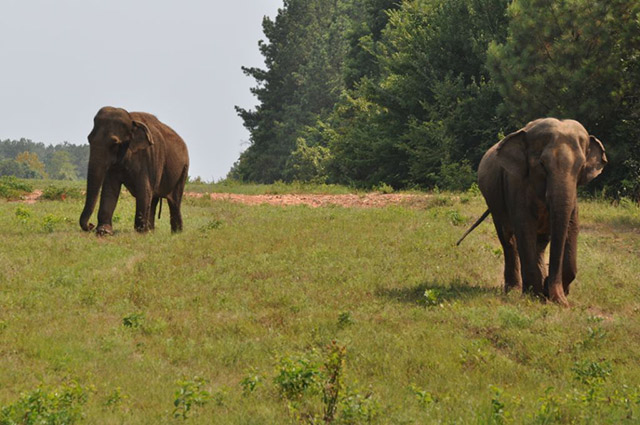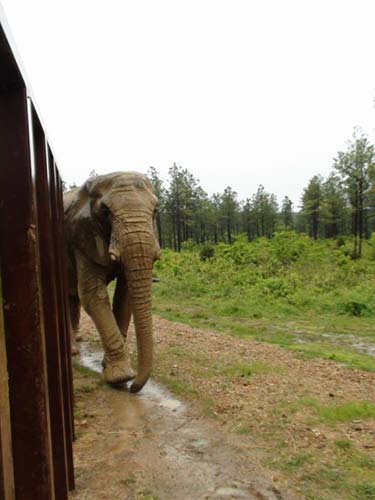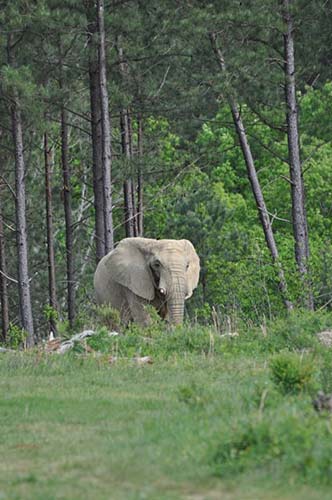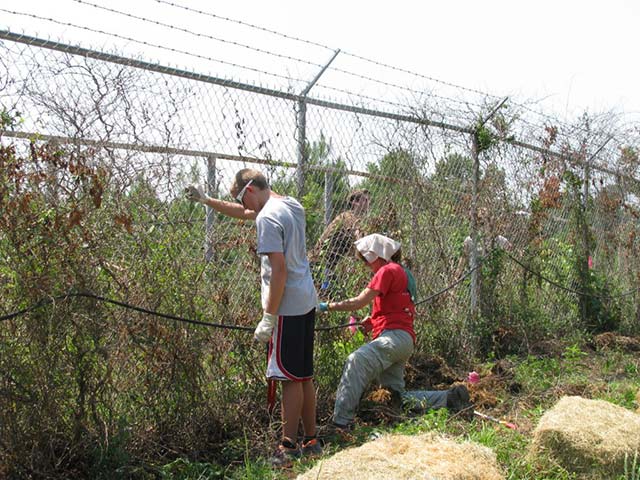In Asia

A new PC training wall built in the habitat enables us to treat Winkie and Sissy
while they are exploring in Asia.
Many of our devoted supporters are interested in the Girls and the Protected Contact training behaviors that are an important part of the Girls’ routine health care, so we thought in this week’s Ele-Notes we would explain some of the procedures. A trunk wash is a routine procedure required annually by the USDA and used to check for tuberculosis (TB). Results are an important indicator that all is well with the Girls. During a trunk wash, saline solution is squirted into the elephant’s trunk. Then, the Girls lift their trunk up high and let the saline solution run back into the bridge of their nose. The last step is when the Girls blow the saline out forcefully into a bag. The saline is then analyzed to see if there is any infection present in the elephant’s respiratory system. Due to her partially paralyzed trunk, Sissy cannot do the "trunk up" that the Girls with fully functional trunks do as part of the trunk wash process. So, that’s where Caregiver creativity came in!
Sissy’s Caregivers came up with a modified "trunk up" to accommodate Sissy's limitations, and she is so trusting and cooperative. Caregiver Laurie explained how they trained Sissy in the process. “We asked Sissy if she would allow us to manipulate her trunk, which she did. As she got used to us doing this, and being showered with praise and treats for being so wonderful, we've progressively been getting her trunk higher and higher. We started with gently pulling the tip of her trunk up just a little past where she could bring it herself, then a bit higher, then above our heads. That was as far as we could get it because a trunk is a VERY heavy thing. We asked Sissy to help us by throwing her trunk up over the top rail of the gate inside the barn which she did enthusiastically! Caregivers ask her to put her trunk on the top rail, (Sissy's version of "trunk up”,) and then we climb on a 3' bench and one person pushes her trunk up over their heads while the other puts treats straight into her mouth.” It’s quite an involved process, and it’s just one example of how our ingenious Caregiver staff works so hard every day to take care of the Girls.
There are several Protected Contact behaviors which enable the Caregivers to more easily perform foot work in a PC setting. They involve lifting a specific foot and then placing the same foot on a bar for filing and trimming of the foot pad and nails. Caregiver Kristy wrote about her experiences working with Dulary. “When training for specific behaviors, we focus on the sought-after behavior and work with it until the behavior is considered established. This is done in order to keep the Girls from getting confused while learning, and allows them to not be overwhelmed with too many instructions. It also allows us to build up for the next sought-after behavior.” Dulary mastered the behavior of raising her foot, which she did consistently, but had trouble with the concept of placing her foot on the PC bar. But the hard work, patience, and consistency of the Caregivers during training paid off. “She now consistently places her feet on the bar and target… She is very proud of herself (and appreciates getting her treats as a reward) and it’s very rewarding to see… Yay Dulary!” said Kristy.
Over at Q
.jpg)
Billie keeps her Caregivers on their toes.
Caregiver Kelly at Q writes, “When coming up with a procedure to get a trunk wash from Billie and Minnie, we had to be creative. In order to collect the trunk wash, we normally train the Girls to put the end of their trunk into a Ziploc bag and then ask them to blow the sterile water out of their nose and into the bag. Since Billie and Minnie always keep us on our toes, and are always ready to play with whatever they can grab, we decided to use something that won't make contact with their trunk in order to avoid this. Attaching a bucket at the end of a bamboo stick was just the trick we needed. Now, when we are ready to collect a trunk wash sample, we simply slide the bamboo stick with the bucket attached to it just out of their reach and ask them to blow into the bucket. We can then collect the sample perfectly without the possibility of the Girls getting a zip lock bag for lunch! Also, it keeps the procedure much safer for the Caregivers.”
At Africa

When Flora approaches the PC wall in her habitat,
she chooses to be an active participant in her health care.
Blood collection as required by the USDA is also a part of routine health care. PC training behaviors for blood collection are important. It takes multiple steps and a lot of patience on the part of both parties to acclimate an animal to participate in medical procedures. To draw blood, the Caregiver staff trains the Girls to place their ear through a Protected Contact training wall. After the Girls are acclimated to having their ear handled and manipulated, the final step is attaching a butterfly blood collection tube to a vein in the ear. A tiny tube runs from the needle down to the collection tube, so that flapping ears don’t allow the needle to dislodge easily. Flora’s Caregivers and Deb, The Sanctuary’s Vet Tech, were thrilled to see how calm and cooperative Flora was last week for a blood draw. Deb says, “Flora didn’t even seem to realize what happened at first. After a few moments, it was if it dawned on her, and she reached her trunk up and touched her ear.” Caregiver Kristy writes about Flora and her participation in PC training for blood collection. “It has been a surreal experience to see Flora’s trust and patience with us during her PC sessions. Any animal caregiver knows what a big deal it is when an animal allows you to do something like this… to stand there willingly and allow us to pick up their feet, give them medicine, or stick them with a needle to draw blood. When you step back and look at the process as a whole, it is something that cannot be taken lightly or for granted. Collecting blood from Flora is a testament that we created a stress free environment for her. So much that she felt comfortable enough to return and participate again the next day with no reaction. Flora has quickly become one of my favorite girls to work with! Seeing Flora move forward and allowing me to be her trainer that day was so incredible. It has been one of my favorite moments during my time here at The Sanctuary.”

Flora surrounded by her beautiful woods.
Caregiver Kristy was also able to work with the volunteers last Saturday, and wanted to express her heartfelt thanks to all of the individuals she met. Outdoor Volunteer Day opportunities are filled for 2012 with a waiting list. If you’d like to participate next year, be sure to enroll in E-Trunklines and respond ASAP after you receive the e-mail announcing registration. A special thanks to all of our hardworking volunteers.
“I just wanted to take a moment to say how appreciative I am of our volunteers. Each group I work with always show up raring to go with great attitudes and enthusiasm. They are all amazingly dedicated, hard-working, eager to learn, and willing to keep going on any job you lay before them. This Saturday, I was inspired by some that traveled over 13 hours to come and do laborious work in 100 degree temperatures. A special thank you to those who volunteer; it keeps us as Caregivers completely humbled and appreciative of our job that we do here.” – Caregiver Kristy

Volunteers worked in the hot Tennessee sun this past weekend clearing fence lines in the habitat.
